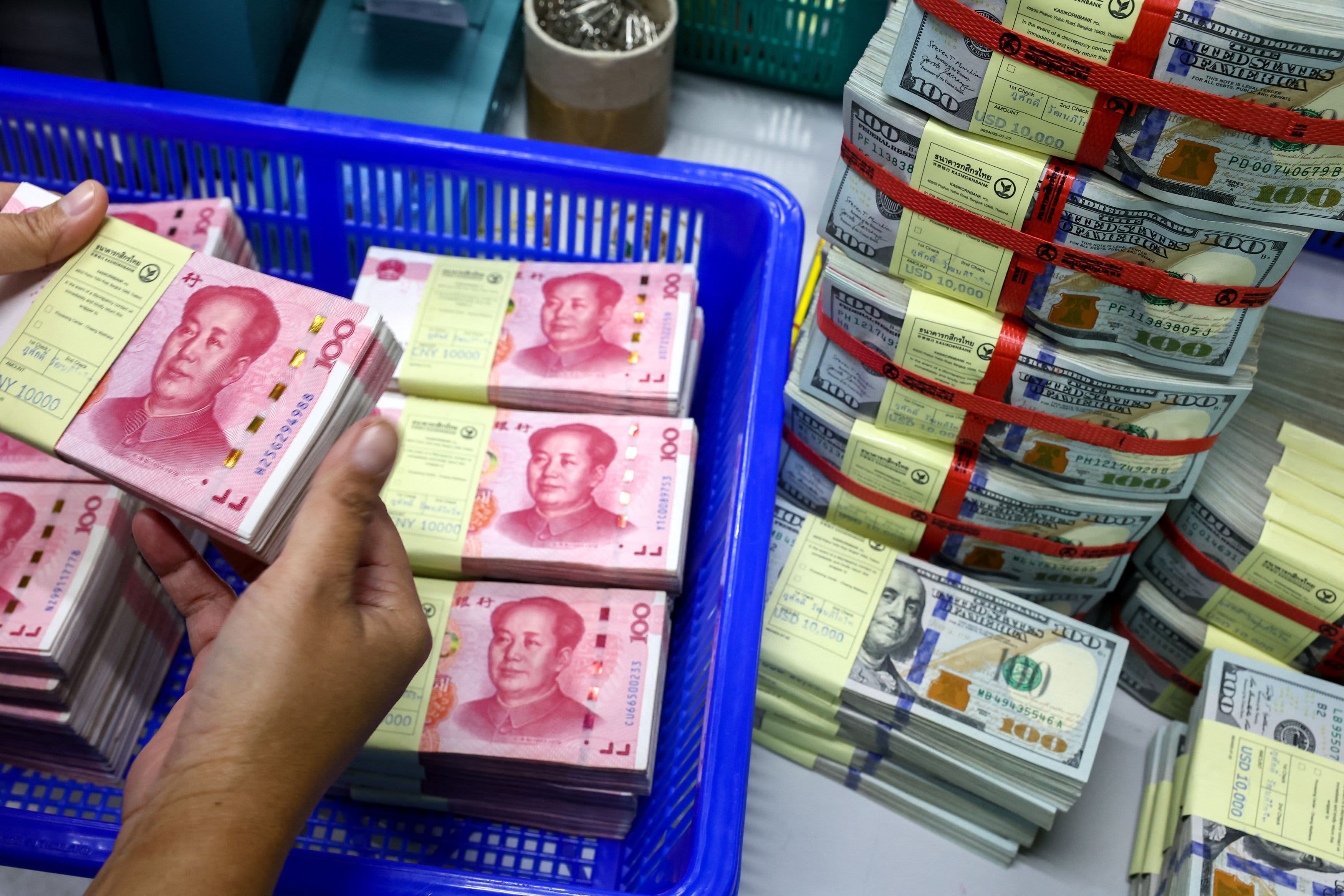
BEIJING — Chinese companies seeking growth from exports face a new challenge: a strengthening yuan.
The “offshore” yuan traded in Hong Kong surged Monday against the U.S. dollar to its strongest level for 2024 — below 7.1 — before weakening slightly to around 7.18 as of Wednesday afternoon, according to Wind Information.
The sharp moves came amid a global stock market sell-off as investors reassessed their outlook for the U.S. economy and potential interest rate cuts. High rates have bolstered the U.S. dollar and related assets.
A strong greenback has also helped keep the Chinese yuan weak, which in turn kept Chinese exports competitively priced abroad. After steadily weakening in the first half of the year, the offshore yuan has strengthened against the U.S. dollar over the last month.
Many trade companies, especially smaller ones, have “currently adopted a strategy of ‘preferring not to take orders rather than take loss-making orders,'” Winnie Wang, president of the Shenzhen Cross-Border E-Commerce Association, said Tuesday in Chinese, according to a CNBC translation.
She noted the case of one such company, which made 20 million yuan ($2.8 million) in revenue during the yuan’s weakening during the first half of the year, allowing it to raise employee salaries. But she said the company did not win a single order in July because the stronger yuan forced it to repeatedly raise its prices.
Ryan Zhao, director at an export-focused company called Jiangsu Green Willow Textile, said Tuesday that recent fluctuations in foreign exchange will cut into about 2% of profits on accounts receivable this month.
“We are concerned that a prolonged appreciation of the yuan will lead to price increases by Chinese suppliers, which will affect the export businesses,” he said in Chinese, according to a CNBC translation. He said the company’s way of dealing with exchange rate fluctuations is to negotiate a middle exchange rate with the customer.
China reported slower-than-expected growth in U.S. dollar-denominated exports for July on Wednesday, while imports surprised with a better-than-expected increase.
Exports have stood out as a bright spot as China’s economic growth slows. Many local companies from automakers to e-commerce players have accelerated overseas expansion plans to capture opportunities for faster growth abroad.
That also means Chinese companies are now more exposed to currency fluctuation risks. China’s foreign exchange regulator has in the last two years published guides on how businesses can mitigate such risks.
“Apart from geopolitical reasons, Chinese companies are increasingly focused on hedging currency risk because they are localizing operations globally – which makes their operations more complex than they used to be,” said Chris Pereira, president and CEO of consulting firm iMpact.
“In addition to hedging against traditional USD/RMB fluctuations, Chinese cross-border e-commerce companies are increasingly also hedging against the Euro, British Pound, and Japanese Yen,” he said Tuesday. Cross-border e-commerce refers to online shopping platforms selling products between different countries.
Pereira said many of his clients work with fintech companies such as Airwallex and LianLian Pay. “Larger Chinese cross-border e-commerce companies generally work with banks to secure forward contracts or options, allowing them to lock in exchange rates for future transactions,” he said.
Changing expectations
Global businesses and investors have increased their focus on currency risk in recent days. Many institutional investors on Monday started to unwind a popular ”carry trade” in the Japanese yen, which had played an attractive role in global asset allocation until the Bank of Japan raised interest rates last month to their highest since 2008.
The Chinese yuan has held a similarly attractive role due to low interest rates in China. But several analysts expected that could change.
“A large amount of foreign currency is awaiting settlement” against the yuan, Zhou Ji, macro FX analyst at Nanhua Futures, said in Chinese translated by CNBC.
Zhou noted lack of willingness to settle earlier in the year due to widespread expectations that the yuan would weaken against the U.S. dollar, a view partly supported by the People’s Bank of China’s latest interest rate cuts.
Fast-fashion giant Shein and PDD Holdings’ Temu are two of the most well-known examples of Chinese cross-border e-commerce companies. Many small businesses — which may have their own factories in China — have entered the industry to sell on TikTok, Amazon.com or platforms run by Alibaba.
Chinese policymakers have also encouraged the development of cross-border e-commerce by supporting special economic zones and overseas warehouse construction.
Official data claim explosive growth in the industry, with more than 120,000 cross-border e-commerce entities in China as of June.
Such online international commerce grew by 10.5% year-on-year in the first half of the year to account for nearly 5.8% of total trade, according to CNBC calculations of official data. That’s up slightly from a share of about 5.7% in the first quarter. A breakdown by exports and imports for the first half of the year was not immediately available.
Wang from the Shenzhen Cross-Border E-Commerce Association pointed out that large Chinese companies have tended to negotiate deals with business partners to mitigate currency risks.
For many smaller businesses, their expansion overseas has been part of an effort to move capital outside China, making them less affected by the latest currency moves, said Chris Sun, founder and CEO of BrandPal, an AI-based marketing company focused on short video monetization. The company claims its backers include Plug and Play Tech Center.
He said the companies, many newly registered in the last year or two, have focused on spending yuan within China while making U.S. dollars via overseas sales.
Source: CNBC
